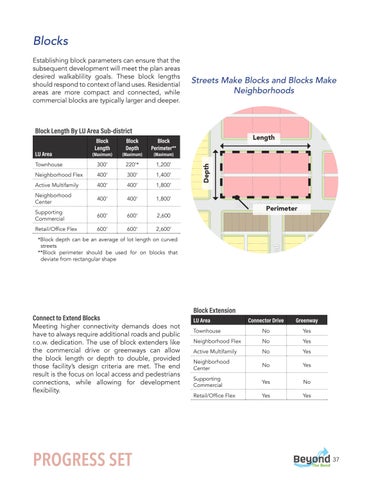Blocks Establishing block parameters can ensure that the subsequent development will meet the plan areas desired walkablility goals. These block lengths should respond to context of land uses. Residential areas are more compact and connected, while commercial blocks are typically larger and deeper.
Streets Make Blocks and Blocks Make Neighborhoods
Block Length By LU Area Sub-district (Maximum)
Block Depth
(Maximum)
Block Perimeter**
Townhouse
300’
220’*
1,200’
Neighborhood Flex
400’
300’
1,400’
Active Multifamily
400’
400’
1,800’
Neighborhood Center
400’
400’
1,800’
Supporting Commercial
600’
600’
2,600
Retail/Office Flex
600’
600’
2,600’
(Maximum)
Meeting higher connectivity demands does not have to always require additional roads and public r.o.w. dedication. The use of block extenders like the commercial drive or greenways can allow the block length or depth to double, provided those facility’s design criteria are met. The end result is the focus on local access and pedestrians connections, while allowing for development flexibility.
PROGRESS SET
Local
Collector/Arterial Perimeter
Local
*Block depth can be an average of lot length on curved streets **Block perimeter should be used for on blocks that deviate from rectangular shape
Connect to Extend Blocks
Length
Depth
LU Area
Block Length
Block Extension LU Area
Connector Drive
Greenway
Townhouse
No
Yes
Neighborhood Flex
No
Yes
Active Multifamily
No
Yes
Neighborhood Center
No
Yes
Supporting Commercial
Yes
No
Retail/Office Flex
Yes
Yes
37









